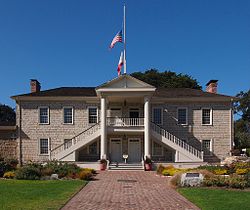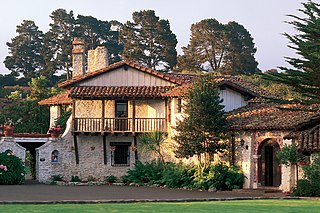
Monterey is a city located in Monterey County on the southern edge of Monterey Bay on the U.S. state of California's Central Coast. Founded on June 3, 1770, it functioned as the capital of Alta California under both Spain (1804–1821) and Mexico (1822–1846). During this period, Monterey hosted California's first theater, public building, public library, publicly funded school, printing-press, and newspaper. It was originally the only port of entry for all taxable goods in California. In 1846, during the Mexican–American War of 1846–1848, the United States Flag was raised over the Customs House. After Mexico ceded California to the U.S. at the end of the war, Monterey hosted California's first constitutional convention in 1849.

The Native Sons of the Golden West (NSGW) is a fraternal service organization founded in the U.S. state of California in 1875, dedicated to historic preservation and documentation of the state's historic structures and places, the placement of historic plaques, and other charitable functions in California. In 1890 the organization placed California's first marker honoring the discovery of gold, which gave rise to the state nickname, "The Golden State". U.S. President Richard M. Nixon and Chief Justice Earl Warren served terms as presidents of the NSGW.

Monterey State Historic Park is a historic state park in Monterey, California. It includes part or all of the Monterey Old Town Historic District, a historic district that includes 17 contributing buildings and was declared a National Historic Landmark in 1970. The grounds include California's first theatre, and the Monterey Custom House, where the American flag was first raised over California.

Stephen Clark Foster was a politician, the first American mayor of Los Angeles under United States military rule. Foster served in the state constitutional convention, and was elected to the State Senate. He was elected as mayor of Los Angeles in 1856, and later elected for four terms to the Los Angeles County Board of Supervisors.

Reverend Walter Colton was an American clergyman and writer from Vermont who served as the first American Alcalde (mayor) of Monterey, California. He worked as an editor for newspapers in Washington, D.C., and Philadelphia, as a chaplain in the United States Navy and as co-publisher of California's first newspaper, The Californian, in 1846. He wrote several books about his travels to California and Europe.

Don Miguel de Pedrorena was a Spanish-born Californio ranchero, merchant, and a signer of the California Constitution in 1849. He also served briefly as acting Alcalde of San Diego (mayor).
The history of Sacramento, California, began with its founding by Samuel Brannan and John Augustus Sutter, Jr. in 1848 around an embarcadero that his father, John Sutter, Sr. constructed at the confluence of the American and Sacramento Rivers a few years prior.

Captain José Antonio Ezequiel Carrillo (1796–1862) was a Californio politician, ranchero, and signer of the California Constitution in 1849. He served three terms as Alcalde of Los Angeles (mayor).

Gardner Quincy Colton was an American showman, medicine man, lecturer, and former medical student who pioneered the use of nitrous oxide, or laughing gas, in dentistry.
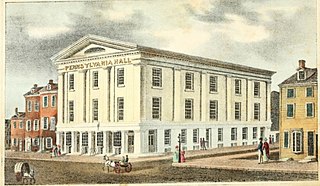
Pennsylvania Hall, "one of the most commodious and splendid buildings in the city," was an abolitionist venue in Philadelphia, built in 1837–38. It was a "Temple of Free Discussion", where antislavery, women's rights, and other reform lecturers could be heard. Four days after it opened it was destroyed by arson, the work of an anti-abolitionist mob.

The Californian was the first California newspaper.

The California Constitutional Conventions were two separate constitutional conventions that took place in California during the nineteenth century which led to the creation of the modern Constitution of California. The first, known as the 1849 Constitutional Convention of Monterey, held in September and October 1849 in advance of California attaining U.S. statehood the following year, adopted the state's original constitution. This document maintains jurisdiction along with the current constitution which was ratified on May 7, 1879, following the 1879 Constitutional Convention of Sacramento. Article 3 Section 2 of the current Constitution references the original boundaries as stated in the 1849 Constitution at Article 12. The result of Progressive mistrust of elected officials, this later constitution took a full year to finalize and has been described as "the perfect example of what a constitution ought not to be". Multiple calls for a third state constitutional convention have been raised during the past quarter-century, but none has thus far gained widespread political momentum.
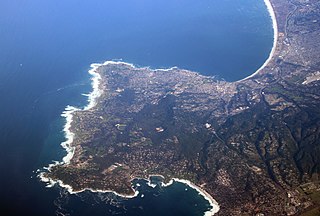
The Monterey Peninsula anchors the northern portion on the Central Coast of California and comprises the cities of Monterey, Carmel, and Pacific Grove, and the resort and community of Pebble Beach.

Harry Ashland Greene was an American businessman and philanthropist. A native of San Francisco, he founded the stockbrokerage firm Greene and Co. there but spent the last 43 years of his life in Monterey, California. He became an influential figure in the development of Monterey and the preservation of its historical landmarks. Among his initiatives were the creation of the city's first electricity company, the construction of the Monterey harbor breakwater, and the preservation of Colton Hall where California's first constitutional convention was held. A keen horticulturalist by avocation, he was the founder and first president of the Federation of Tree-Growing Clubs of America.
The interim government of California existed from soon after the outbreak of the Mexican–American War in mid-1846 until U.S. statehood in September, 1850. There were three distinct phases:

The Guerra family is a prominent Californio family of Southern California. Members of the family held extensive rancho grants and numerous important positions, including numerous Mayors of Santa Barbara, California Senators, a Lieutenant Governor of California, and a signer of the California Constitution.

Don Antonio María Pico was a Californio politician, ranchero, and a signer of the California Constitution in 1849. He also served twice as Alcalde of San José.
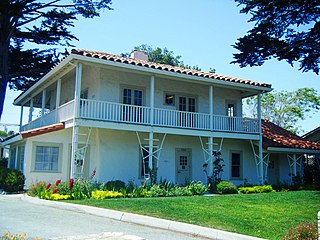
The Vásquez House, also known as Vásquez Adobe, is a historic two-story adobe building located at 546 Dutra Street in Monterey, California. It was occupied by Dolores a sister of Tiburcio Vásquez (1835–1875), who was a Californio bandido that was active in California from 1854 to 1874. The building is listed as a California Historical Landmark #351. It is owned by the City of Monterey, which uses it as the administrative office of its Park and Recreation Department.

The Superior Court of California, County of Monterey, also known as the Monterey County Superior Court or Monterey Superior Court, is the branch of the California superior court with jurisdiction over Monterey County.
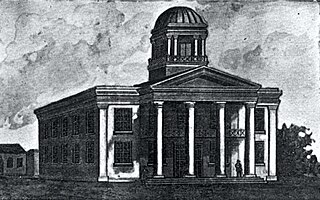
Sacramento First Courthouse also, Former California State Capitol site, is historical site in Sacramento, California. The Courthouse was also the first and second California State Capitol. The site is California Historical Landmark No. 869, registered on January 11, 1974. At the northwest corner of 7th Street and I Street, 651 I Street, Sacramento was a building that served as California's State Capitol. The first period was January 16, 1852 to May 4, 1852, and the second period was from March 1, 1854, to May 15, 1854, with the California State Legislature third and fifth sessions. The 651 I Street building was the Sacramento County courthouse. The site of former California State Capitol - Sacramento County courthouse is now the Main Sacramento County Jail built in 1989. A California Historical marker was place at the site in 2007 by California State Parks working the Sacramento Trust for Historic Preservation.
